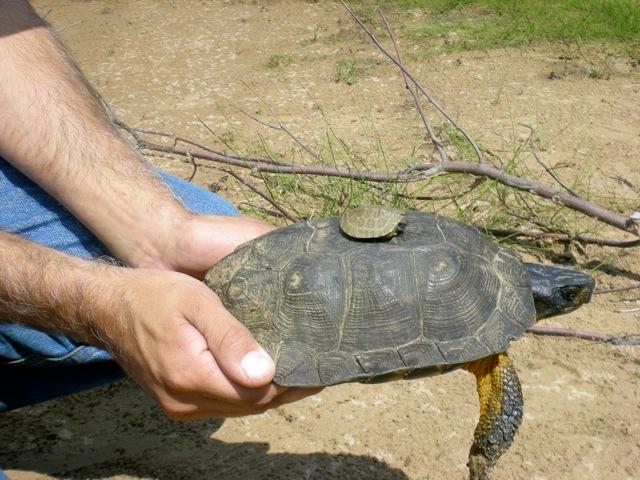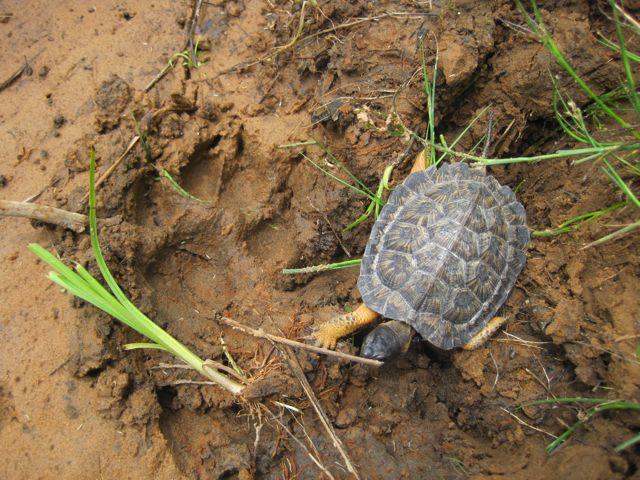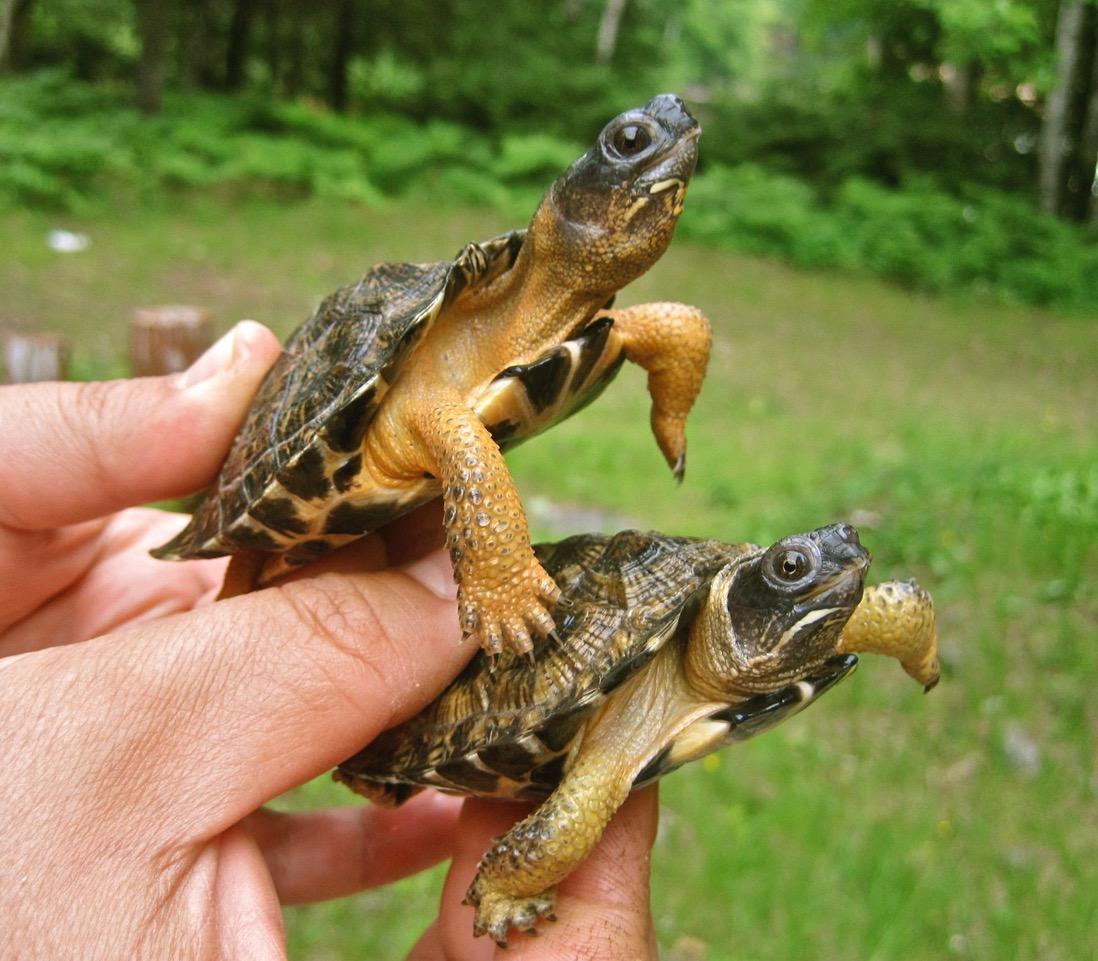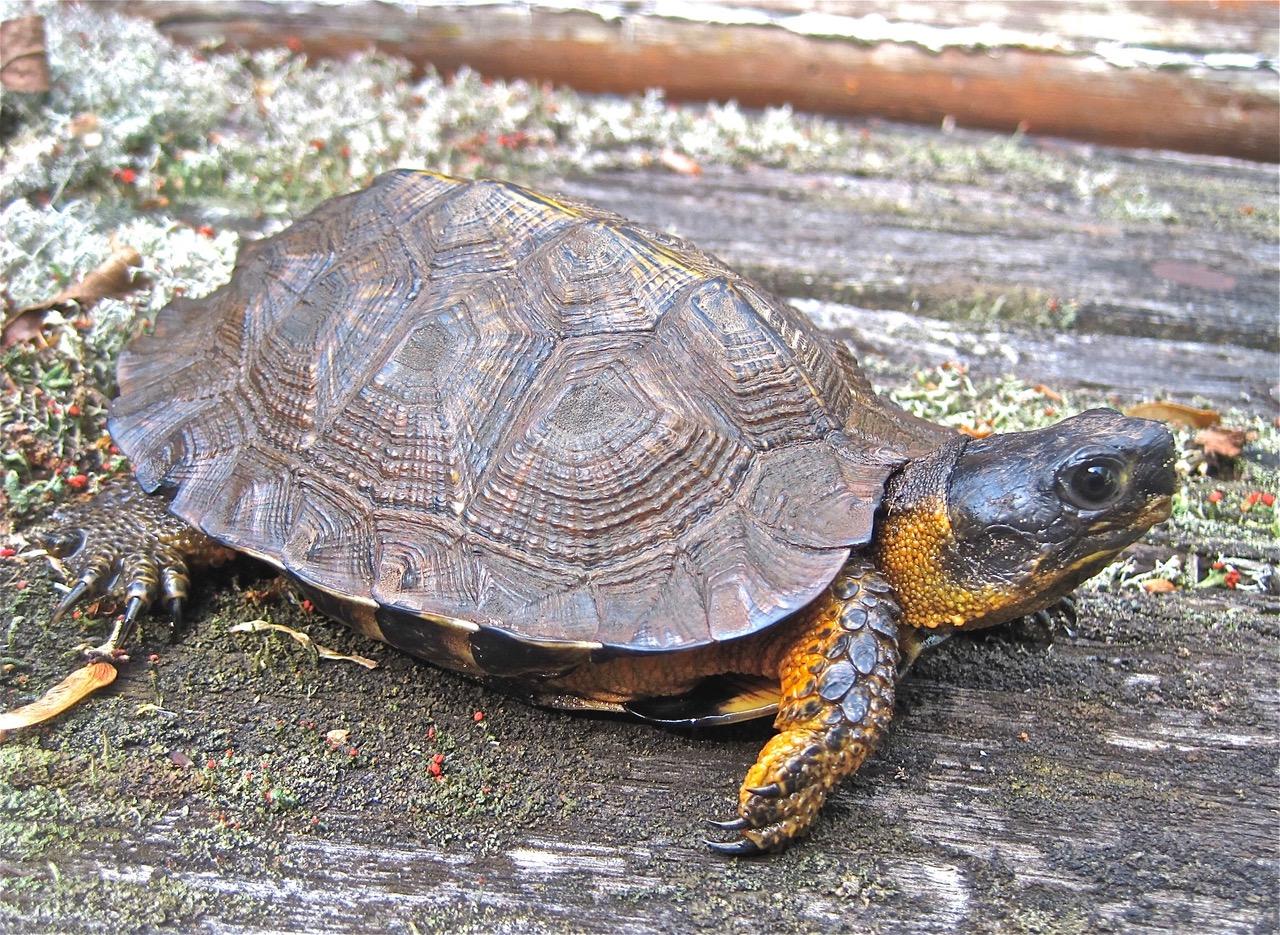The expansive meadow I was walking through was bright with spring wildflowers. In the stream native brook trout scooted over clean gravel. Wild turkeys strutted along a distant ridge. Red-winged blackbirds caroled from swaying cattails.
And wood turtles foraged in high grass. Some were pushing eight inches in length.
Their carapaces, ornate with pyramids flecked yellow and ringed with intricate spiderweb patterns, looked like they’d been carved from black walnut. Legs and necks were splashed with orange, plastrons blotched with black and gold.
Several of these animals might have been here for 70 years.
Wood turtles, spottily distributed from the Lake States to the Maritimes and south to Iowa and Virginia, are endangered in fact if not by federal decree. They don’t reach sexual maturity until they’re about 15 years. Their survival strategy is longevity, not fecundity. Never is there a “harvestable surplus.”
Unlike abundant painted turtles which can escape predators by diving off logs and swimming away, wood turtles spend most of the warm months on land. People unfamiliar with turtles and state laws pick them up and take them home. Poachers gather whole populations and sell them.
On the domestic black market poached wood turtles bring about $400 each, but these days most are smuggled out of the country and sold overseas for much higher prices.

Especially galling to wood-turtle managers is that after they’ve painstakingly restored habitat and rebuilt populations, these strongholds become prime targets for poachers.
Dr. Michael Jones of the Massachusetts Division of Fisheries and Wildlife (MassWildlife) offers this: “We need a better, more coordinated approach to the illegal trade, much stronger disincentives.”
Because the species isn’t federally listed as threatened or endangered the only thing inconveniencing poachers is a patchwork of state laws. If they collect wood turtles in, say, Pennsylvania and take them to, say, Florida without the U.S. Fish and Wildlife Service (USFWS) apprehending them for transporting illegally taken wildlife across state lines (a Lacey Act violation), they’re probably home free. The burden of proof is on the feds.
With the wood turtle’s closest relative, the bog turtle, the burden of proof is on the possessor. The bog turtle is federally endangered, and anyone caught with one in the U.S. or its territories must produce a permit or get busted.
Access Kills
The wood turtles I saw foraging in the meadow are there because the public isn’t.
The meadow is part of a sanctuary I’ve been involved with that’s devoted strictly to wildlife, not recreation.
Artist, naturalist and writer David Carroll, who discovered our wood-turtle population and convinced us to purchase the meadow, fights a never-ending battle with officials, locals and environmental groups pushing to open all wildland for recreation.
“Poaching is a big problem,” Carroll told me. “But inviting the world into wood-turtle habitat is bigger. Whenever you bring in the public wood turtles disappear. People pick them up. Wood turtle populations can’t take that. They can persist if their habitat is protected, but the thing I can’t sell is exclusion of public access. All the decisions are in favor of access and development. Thank God for your sanctuary’s resolute commitment to protect wildlife for wildlife’s sake instead of creating a human playground or theme park, which is what so many ‘conservation areas’ have become.”
Before we purchased the meadow it was hayed several times a year with disk mowers, which diced up everything, wood turtles included.
“When we learned we had wood turtles in large numbers we did away with commercial hay mowing,” says our forester, whom I can’t name because of security protocol. “And that cost me a lot of suffering. Our worker bees who ran the mowing machines wanted to mow. They wanted open farmland. Their vision of habitat didn’t include things like native plants and thickets for birds; it was all ‘brush’ to them. Walk through a wildflower meadow and walk through a recently cut hay lot, and you’ll see two different worlds.”
In order to preserve other meadow-dependent species, we can’t allow natural succession. So we mow only once and in late fall when nectar-producing plants have dropped seeds and wood turtles are moving into the stream to hibernate. Recently the sanctuary has added sand for additional wood-turtle nesting habitat.
Our population is relatively robust. Sometimes you can find five or six wood turtles in one outing — almost unheard of these days. But naturalist Louis Agassiz reported that in Lancaster, Massachusetts, he and friends had “at times collected over one hundred in an afternoon.” The year was 1854. Such has been the species’ range-wide decline.
Seeing Ghosts
Skunks and raccoons, proliferating on human garbage, take an enormous toll on wood turtle eggs and hatchlings.

That problem seems to be lessened when ecosystems retain all parts. “This is just anecdotal,” says herpetologist Jim Harding of Michigan State University, “but two years ago I checked wood turtle nests with a couple friends. We had access to a motorboat, so we covered lots of sandbars and saw lots of nests destroyed by raccoons. Those few sandbars where we saw wolf tracks were totally free of raccoon predation. I sure would love to see more wolves move in. Some people think coyotes are good raccoon predators. I haven’t seen any evidence of that. If I were a coyote, I wouldn’t want to tackle an adult raccoon. But wolves are big enough.”
Harding has documented what he calls “ghost wood-turtle populations.” “Sometimes you can go down a stream and see adults,” he says, “and you think they’re doing okay. But you could be seeing the tail end of the story. If they’re not reproducing at a rate to cover their mortality, decline is inevitable. Every time an old breeder is hit by a car, picked up by a kid or chewed up by a dog, that’s minus one, and there may not be enough juveniles coming along to make up for it.”
A Head Start for Wood Turtles
So what’s being done to recover wood turtles?
One tool is “headstarting.” Eggs taken from the wild are incubated. And the hatchlings, fed in captivity, can put on three years’ worth of growth in nine months, thereby becoming much less vulnerable to predators.

But headstarting is extremely labor intensive. Juveniles are started off in groups. Then, in a few weeks, each goes into its own bin. Otherwise they’d bite off legs, toes and tails. It’s not that they’re vicious; it’s just that in the wild they’re always alone and have no instinct to recognize siblings. Anything that moves is potential food.
Harding suspects that just saving eggs from predators and releasing hatchlings may be nearly as effective.
MassWildlife’s Jones sees headstarting as a potential distraction from land conservation and other priorities unless it’s “applied strategically and with sustained effort.”
“It’s easy to conflate different turtle species,” he says. “When headstarting began for northern red-belied cooters [in Plymouth County, Massachusetts] they were at the absolute northern extent of their range and stressed by relatively cool summers.
So headstarting has been a logical way to stabilize that population, especially in the context of our regional warming trend. But that same warming trend is stressing the wood turtle, which depends on coldwater refugia.”
And climate change is producing off-the-chart floods. When they occur in winter they can blast hibernating turtles out of their habitat, especially in streams hardened with rip-rap or revetments and whose floodplains have been developed.
Beyond Postage-Stamp Protection
But wood turtles may be more resilient than managers had thought. Jones grew up on Massachusetts’ north shore. Until three years ago no wood turtle had been seen in his town since the late 19th century. Then a female showed up, digging a nest in someone’s garden. Jones and his colleagues eventually found a dozen wood turtles in the nearby stream. The population had been hanging on under peoples’ noses.
Despite all the threats to wood turtles Jones feels more optimistic about their future than when he started working on them 15 years ago. At least now state resource agencies and the USFWS are paying attention, doing what they can to protect and rebuild existing populations.
MassWildlife and Zoo New England have just launched a joint project to recover wood turtles in eastern Massachusetts where populations have been devastated by development. Turtles will be tracked with radio telemetry to identify urgent management needs as well as opportunities to expand existing populations. There will also be sustained headstarting.
And MassWildlife is the lead agency in a 13-state conservation plan identifying, protecting and enhancing the best remaining wood-turtle habitats.

“Postage-stamp efforts across the whole region don’t work well for this species,” Jones says. “You need to pick a basin and put together a comprehensive conservation strategy. We need to do better about choosing the streams we’re absolutely going to get right. At the same time we should be working on restoration opportunities wherever they arise.
“It would be easier to mobilize partners to conserve these habitats if we could publicize the locations, but we can’t because of poachers. While some of these sites have agriculture, we think a lot of the damage can be undone through better practices.”
If you spend enough time in wood-turtle country, you’ll encounter one of these beautiful animals. Perhaps it will be emerging from hibernation and easing over the bed of an ice-rimmed stream or, later in the season, daintily plucking dandelions and mushrooms. Maybe you’ll come upon a courting pair, the male swinging his head atop the female’s carapace, or a female plodding to a sunny, sandy spot to lay eggs. And if you’re persistent and lucky, you’ll see one stomping its feet and banging its plastron against wet earth to scare up worms.
Cool Green Science readers can help by reporting wood-turtle sightings to state wildlife managers…and to no one else.




When I was a kid, in the mid 70s, we would track wood turtles on the sandbars by the Souhegan River in Amherst NH (neer the country club) and keep them in pens in the back yard along with Blandings turtles and others. We always released them before going back to school in the fall. I moved away from that area in the late 70s. Not sure if they are still there given all the development over the years.
3/7/24
*** Does anyone knoow of any remnant wood turtle (or historical ones…) in the NH Lakes Region? I live in a group home called: LRCS’s SR2 in ‘Monarch Meadows’ (my appelation after having several Monarch Butterflies land on me out in the meadow!) 240 South Road Belmont, NH 03220-4415 (603-527-8225) [brianinbelmont@gmail.com]
Ted,
What are the 13 states involved in this Wood Turtle project. I remember one Spring about 25 years ago where I discovered at least 8 mature Wood Turtles in early Spring just after the Winter thaw just basking in the woods of an adjacent protected park near my home. This park has several streams and a small lake and also considerable meadow habitat. Ever since that time, I have scoured those woods with no success in early Spring or throughout the Spring for that matter. Thanks for the wonderfully informing article. Mike Wells in SE Michigan
I found this article very informative and interesting about the wood turtle. I have always found or seen box turtles, maybe a snapping turtle around a pond.
It has opened my eyes and mind to care even more about the species.
thank you for the information on the wild things to be saved. it helps the understanding and donation to the cause helps.
I know this will be considered blasphemy by some, but the only thing that will stop the poaching is captive breeding for the pet trade. Once enough of these turtles get into the market, prices will fall and so will the incentive for poaching. While it would be nice if laws would be enough to protect these turtles, the article itself makes it obvious that laws have not worked, nor will they with the demand so high. And before anyone says it, no, I’m not involved in the pet trade, nor do I want to own one of these turtles. But years of watching laws being passed with little or no effect has led me to look at other solutions. And this is the only one I know o f that has consistently worked.
I dont think I have ever seen a wood turtle – snappers, yes (crossing the road!) I hope there is a possibility of some or one living in my small fields & brush around me. Other than mowing paths for myself & my dog to walk – the rest is left alone. Have lots of deer moving thru – used to have a huge flock of turkeys years ago but very seldom see them anymore. Love reading about all wildlife. I believe there would be more compassion & empathy for the wild if only more people were interested enough to read about it. It seems now with the vast increase of “tourists” advancing on parks & refuges etc for the most unique selfie – our native animals & their habitat are more & more at risk – rather than less. Keep up the good work.
As a kid growing up in Massachusetts, I searched high and low for woodies, all through New England and never found one. It took a move to California to finally meet one in the flesh. It is heartening to read of their survival and the great work coservationists are doing.
George McRae
Great article. It reminded me of when I was a child in the 70s and my family would go camping in a place in southern Wisconsin that was later bought by TNC because of its amazing biodiversity. I found wood turtles there and, because I was young and turtle obsessed, I brought one home with me as a pet. It escaped on the second day and I never saw it again. I hope that they get the conservation attention they deserve. And I hope the reserve continues to hold these wonderful animals.
Having grown up on a farm on the Eastern Shore of Maryland I was lucky to have just the right habitats for all manner of turtles and snakes. I often caught box turtles, kept them awhile, feeding them worms and fruit. Then I let them go. In later life, after a full load of conservation and biology courses at Cornell I began to think about wildlife in many other ways. Certainly one of the largest threats to reptiles and amphibians is automobiles. Roads increasingly criss-cross the country and it is difficult for a turtle, for example, to make it from one side to the other. I also have seen (repeatedly) that a certain type of young male human will go out of their way to run over snakes and turtles. I am also convinced that the various pesticides imposed on us are doing the amphibians and reptiles no good at all. Just since we moved to Iowa in 2005 we have seen the insect population crash (and not just the monarchs we here so much about). There is no shortage of milkweed yet people are led to believe that they can help the monarchs by spreading milkweed seeds and apparently are not told about what is happening to monarch habitat in Mexico. In fact, all butterflies have taken a big hit with this year being the first encouraging year we have seen, but numbers are still few for all species. Turtles have to cross roads and drivers will drive over them. Thank goodness there are a few habitats which are large enough to support healthy populations (as long as they stay in the boundaries).
When you were at Cornell did you take any courses from my friend Dr. Harry Greene? He’s an amazing herpetologist. I sure wish I’d had him for a prof.
Fortunately in Michigan turtles have some protection under our game laws with seasons and bag limits that discourage commercial harvest.
I’ve seen many wood turtles through the years, but not so many that each one was not remarkable. I once saw 3 pairs copulating in a stream within 50 yards of each other. That’s a fringe benefit of having worked as a FWS technician surveying streams for Sea lamprey.
Great article. The photos are beautiful. I’ve only seen a handful of woodies in my life–each a precious encounter. May they amble on forever.
I suppose there’s no chance of better protection under this administration. Thanks for writing about them. Damn poachers.
Thank you for this wonderful story. It was a joy to read.
Turtle poachers take a big toll in Iowa as elsewhere. In addition, Iowa commercial turtle trappers have well-placed friends in state government, so state rules are very weak. While some other states had the smarts and gumption to ban commercial turtle harvest, Iowa officials cater to turtle exploiters who moan about “family tradition” and their “way of life.” Iowa is turtle hell.
So it is even more heart-lifting to read about a very special place in another region where small vulnerable beautiful turtles have the protections provided by anonymity and by smart, dedicated, generous people who know and provide what turtles need. I’m very glad the wood turtle place and the wood turtle people in this story will remain unknown. But wherever and whoever you are, thank you so very much.